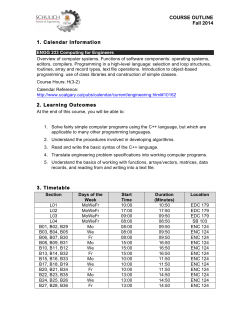
Problem Set 4
CS 225 - Pseudorandomness
Prof. Salil Vadhan
Problem Set 4
Harvard SEAS - Spring 2015
Due: Fri. Apr. 3, 2015
Your problem set solutions must be typed (in e.g. LATEX) and submitted electronically to
cs225-hw@seas.harvard.edu. You are allowed 12 late days for the semester, of which at most 5
can be used on any individual problem set. (1 late day = 24 hours exactly). Please name your file
PS4-lastname.*.
The problem sets may require a lot of thought, so be sure to start them early. You are encouraged
to discuss the course material and the homework problems with each other in small groups (2-3
people). Identify your collaborators on your submission. Discussion of homework problems may
include brainstorming and verbally walking through possible solutions, but should not include one
person telling the others how to solve the problem. In addition, each person must write up their
solutions independently, and these write-ups should not be checked against each other or passed
around.
Strive for clarity and conciseness in your solutions, emphasizing the main ideas over low-level
details. Do not despair if you cannot solve all the problems! Difficult problems are included to
stimulate your thinking and for your enjoyment, not to overwork you. *ed problems are extra
credit.
Problem 5.1. Limits of List Decoding Show that if there exists a q-ary code C ⊂ Σnˆ of rate
n
ρ that is (δ, L) list-decodable, then ρ ≤ 1 − Hq (δ, n
ˆ ) + (logq L)/ˆ
Problem 5.2. Concatenated Codes For codes Enc1 : {1, . . . , N } → Σn1 1 and Enc2 : Σ1 → Σn2 2 ,
their concatenation Enc : {1, . . . , N } → Σn2 1 n2 is defined by
Enc(m) = Enc2 (Enc1 (m)1 )Enc2 (Enc1 (m)2 ) · · · Enc2 (Enc1 (m)n1 ).
This is typically used as a tool for reducing alphabet size, e.g. with Σ2 = {0, 1}.
1. Prove that if Enc1 has minimum distance δ1 and Enc2 has minimum distance δ2 , then Enc
has minimum distance at least δ1 δ2 .
2. Prove that if Enc1 is (1 − ε1 , `1 ) list-decodable and Enc2 is (δ2 , `2 ) list-decodable, then Enc
is ((1 − ε1 `2 ) · δ2 , `1 `2 ) list-decodable.
3. By concatenating a Reed–Solomon code and a Hadamard code, show that for every n ∈ N
and ε > 0, there is a (fully) explicit code Enc : {0, 1}n → {0, 1}nˆ with blocklength n
ˆ =
O(n2 /ε2 ) with minimum distance at least 1/2 − ε. Furthermore, show that with blocklength
n
ˆ = poly(n, 1/ε), we can obtain a code that is (1/2−ε, poly(1/ε)) list-decodable in polynomial
time. (Hint: the inner code can be decoded by brute force.)
1
Problem 5.6. Improved list decoding of Reed–Solomon Codes
1. Show that there is a polynomial-time
p algorithm for list decoding
p the Reed-Solomon codes of
degree d over Fq up to distance 1− 2d/q, improving the 1−2 d/q bound from Theorem 5.19.
(Hint: do not use fixed upper bounds on the individual degrees of the interpolating polynomial
Q(Y, Z), but rather allow as many monomials as possible.)
p
2. (*) Improve the list-decoding radius further to 1 − d/q by using the following “method of
multiplicities”. First, require the interpolating polynomial Q(Y, Z) to have a zero of multiplicity s at each point (y, r(y)) — that is, the polynomial Q(Y + y, Z + r(y)) should have no
monomials of degree smaller than s. Second, use the fact that a univariate polynomial R(Y )
of degree t can have at most t roots, counting multiplicities.
Problem 5.7. Twenty Questions In the game of 20 questions, an oracle has an arbitrary secret
s ∈ {0, 1}n and the aim is to determine the secret by asking the oracle as few yes/no questions
about s as possible. It is easy to see that n questions are necessary and sufficient. Here we consider
a variant where the oracle has two secrets s1 , s2 ∈ {0, 1}n , and can adversarially decide to answer
each question according to either s1 or s2 . That is, for a question f : {0, 1}n → {0, 1}, the oracle
may answer with either f (s1 ) or f (s2 ). Here it turns out to be impossible to pin down either of
the secrets with certainty, no matter how many questions we ask, but we can hope to compute a
small list L of secrets such that |L ∩ {s1 , s2 }| =
6 0. (In fact, |L| can be made as small as 2.) This
variant of twenty questions apparently was motivated by problems in Internet traffic routing.
1. Let Enc : {0, 1}n → {0, 1}nˆ be a code such that every two codewords in Enc agree in at least
a 1/2 − ε fraction of positions and that Enc has a polynomial-time (1/4 + ε, `) list-decoding
algorithm. Show how to solve the above problem in polynomial time by asking the n
ˆ questions
{fi } defined by fi (x) = Enc(x)i .
2. Taking Enc to be the code constructed in Problem 5.2.3, deduce that n
ˆ = poly(n) questions
suffices.
2
© Copyright 2025









